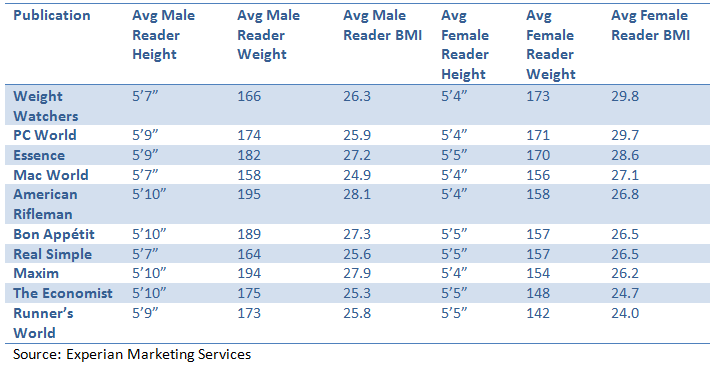A little over 10 years ago, when I was the research editor at American Demographics magazine, I was contacted by the folks responsible for the Simmons National Consumer Study who were interested in knowing what consumer variables our readers were seeking, but not finding, from other sources. I had no trouble telling them that we regularly had marketers looking (unsuccessfully) for data on consumer’s body types—such as height, weight and build—that could be linked to consumer behaviors and brand preferences. These marketers ranged from retailers who were designing clothes for their customers to auto manufacturers trying to understand how much head room they should build into the design of their next vehicle all in an attempt to better understand their customer. In a brilliant move, the Simmons team (now part of Experian Marketing Services) responded by creating the Waistband segments, a consumer segmentation derived by calculating respondents’ Body Mass Index (BMI) from their self-reported height and weight.
Fast forward to today when I read the Ad Week piece on Elle magazine’s use of Emmy award-winning actress and full-figured woman Melissa McCarthy on the cover of their current issue. While much of the controversy surrounded the wardrobe choice for Ms. McCarthy—who, in my opinion, rocked the flowing grey cashmere coat by Marina Rinaldi—I was more interested in how many Elle magazine readers would personally identify with the cover model’s plus-size body type.
Turning to the Simmons dataset, I was quickly able to find that, on average, 41% of Elle’s female readers are either “overweight” or “obese” as determined by the National Institute of Heath’s (NIH) published BMI guidelines. While that rate is considerably lower than the national average—55% of all U.S. women are considered overweight or obese—it still represents a significant portion of Elle’s readers. In fact, the average female Elle reader—90% of Elle readers are women—is 5’4” and weighs 149 pounds. By the NIH’s guidelines, that means the average female reader has a BMI of 25.5, which falls into the lower range of the “overweight” category. (A BMI between 25 and 29.9 is considered overweight. A BMI of 30 or higher is considered obese.)
Like those marketers who contacted me over a decade ago seeking to better understand their customers, Elle publishers, by putting Ms. McCarthy on the cover, have demonstrated that they too understand their audience.
Below is the average height, weight and BMI of some other selected publications broken out by gender.
Read more about the Simmons National Consumer Study and consumer segmentations, including the Waistband segments.
